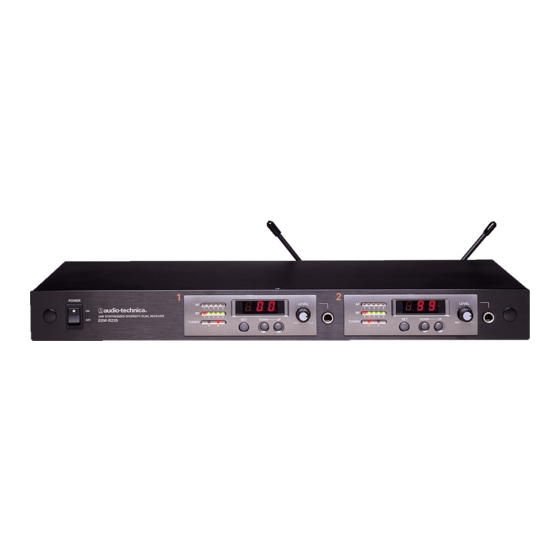Subscribe to Our Youtube Channel
Summary of Contents for Audio Technica ESW-R220
- Page 1 UHF Wireless Systems ESW-R220 UHF Synthesized Diversity Dual Receiver Installation and Operation...
-
Page 2: Receiver Installation
With the addition of two more ESW-R220 dual receiver units, up to six receiver channels can be operated from a single pair of antennas. However, any type of receiver in the same band, or even a separate active antenna divider, may be fed by the antenna outputs. - Page 3 Output Connections There are two audio output jacks on the back for each of the receivers: balanced (4 mV) and unbalanced (40 mV). Use shielded audio cable for the connection between the receiver and the mixer. If the input of the mixer is a connect a cable from the "...
- Page 4 Each output should be connected to only one other antenna input, without “daisy-chaining.” (Using two additional ESW-R220 dual receiver units provides a total of six channels in three rack spaces with a single pair of antennas.)
- Page 5 LED – doing so will cause the system to overload and distort. The audio output level of the ESW-R220 has been optimized for best performance and no adjustment is necessary. The level control on the front panel controls the headphone jack only.
-
Page 6: Specifications
32.768 kHz Operating Range 300' typical Operating Temperature Range 41° F (5° C) to 113° F (45° C) Frequency Response 100 Hz to 15 kHz ESW-R220 RECEIVER Receiving System Dual independent tuners, automatic switching diversity Image Rejection >100 dB Signal-to-noise Ratio >107 dB (IEC-weighted at ±40 kHz... - Page 7 Engineered Sound Designator Frequency (MHz) 728.125 728.250 728.375 728.500 728.625 728.750 728.875 729.000 729.125 729.250 729.375 729.500 729.625 729.750 729.875 730.000 730.125 730.250 730.375 730.500 730.625 730.750 730.875 731.000 731.125 731.250 731.375 731.500 731.625 731.750 731.875 732.000 732.125 732.250 732.375 732.500 732.625 732.750...
- Page 8 Notice to individuals with implanted cardiac pacemakers or AICD devices: Any source of RF (radio frequency) energy may interfere with normal functioning of the implanted device. All wire- less microphones have low-power transmitters (less than 0.05 watts output) which are unlikely to cause difficulty, especially if they are at least a few inches away.

















Need help?
Do you have a question about the ESW-R220 and is the answer not in the manual?
Questions and answers